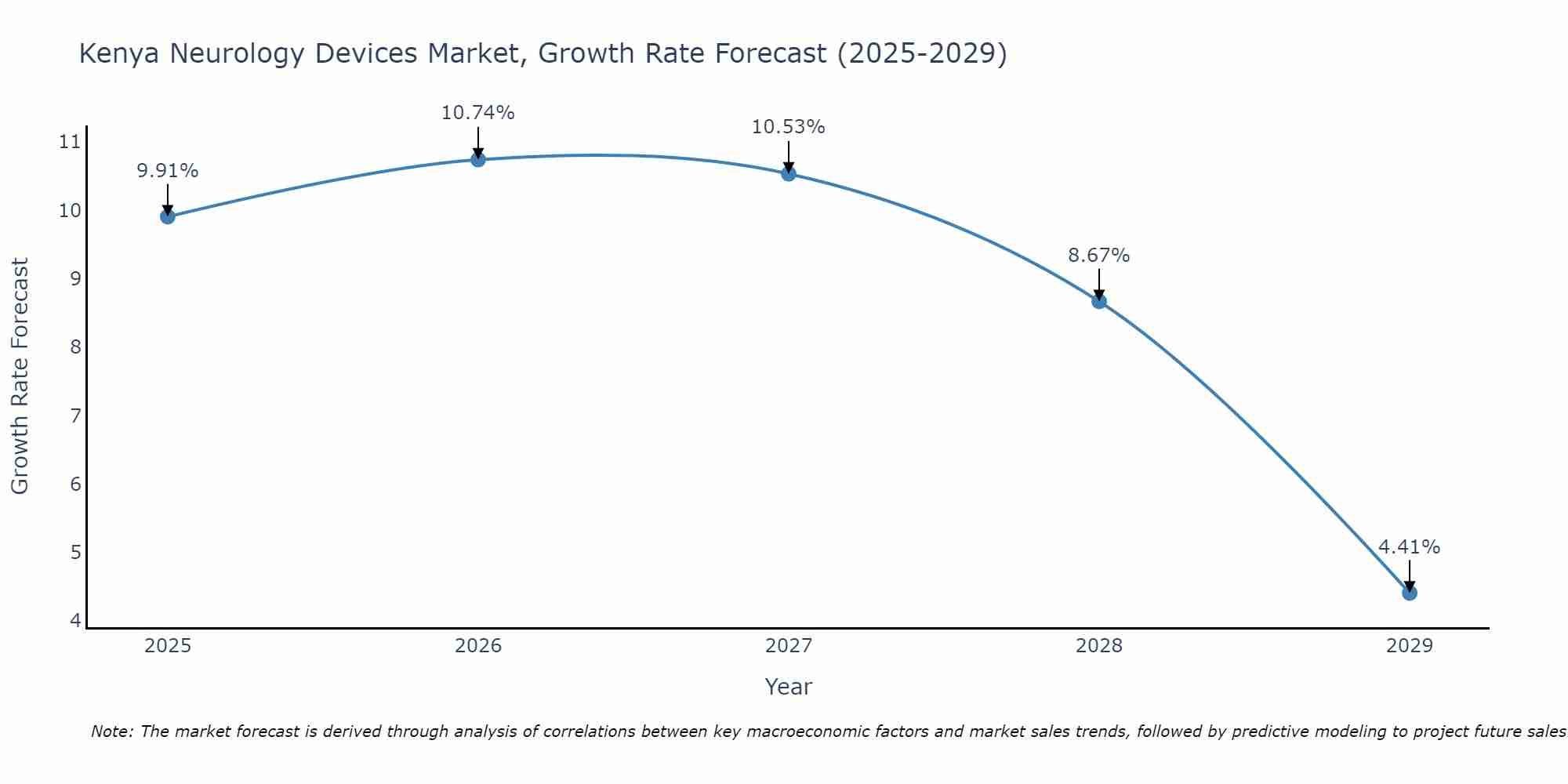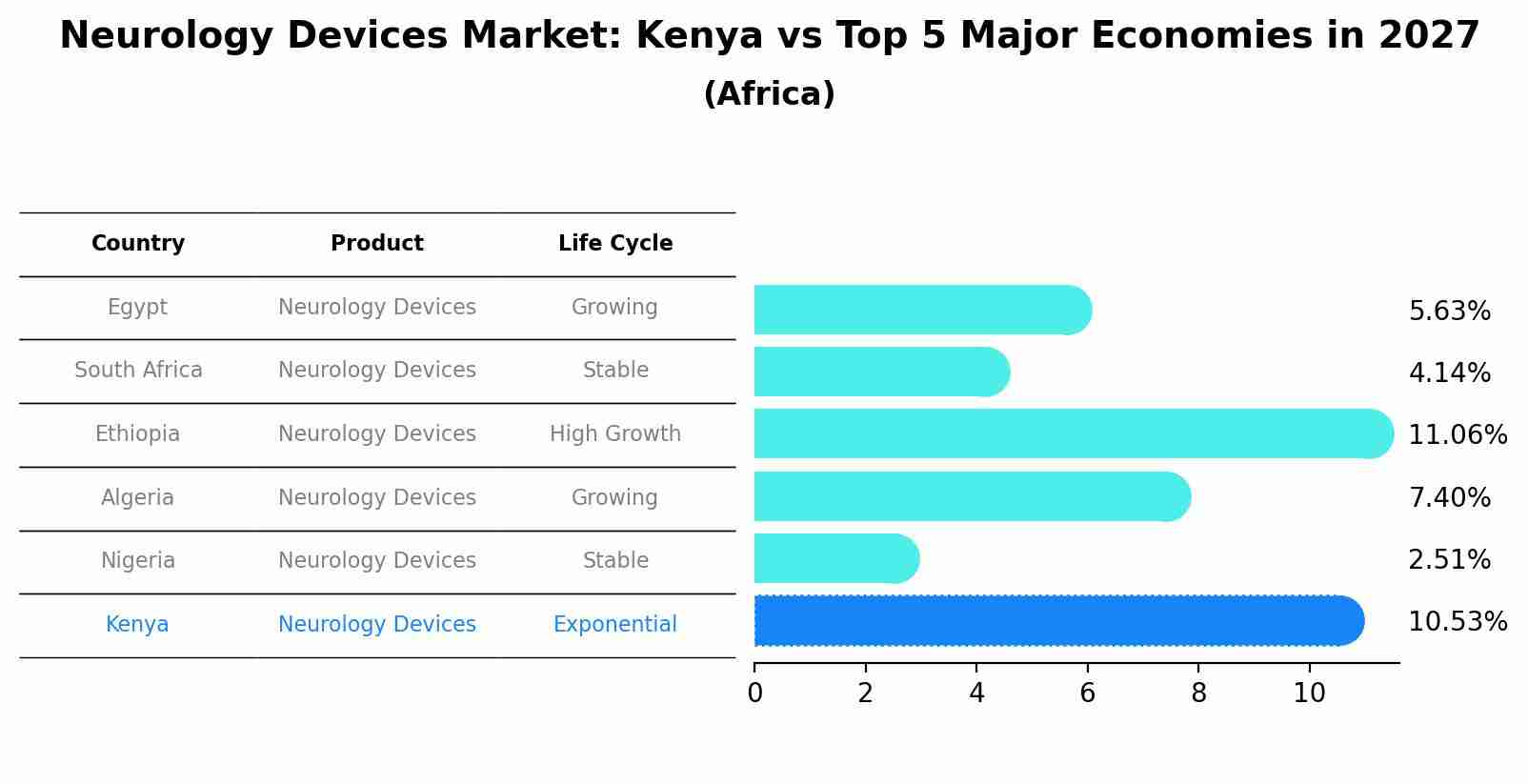Kenya Neurology Devices Market Outlook | Analysis, COVID-19 IMPACT, Industry, Value, Growth, Size, Trends, Share, Revenue, Companies & Forecast
| Product Code: ETC367670 | Publication Date: Aug 2022 | Updated Date: Apr 2025 | Product Type: Market Research Report | |
| Publisher: 6Wresearch | No. of Pages: 75 | No. of Figures: 35 | No. of Tables: 20 | |
Kenya Neurology Devices Market Size Growth Rate
The Kenya Neurology Devices Market is projected to witness mixed growth rate patterns during 2025 to 2029. Starting at 9.91% in 2025, the market peaks at 10.74% in 2026, and settles at 4.41% by 2029.

Neurology Devices Market: Kenya vs Top 5 Major Economies in 2027 (Africa)
Kenya's Neurology Devices market is anticipated to experience a high growth rate of 10.53% by 2027, reflecting trends observed in the largest economy Egypt, followed by South Africa, Ethiopia, Algeria and Nigeria.

Kenya Neurology Devices Market Overview
Kenya neurology devices market involves medical devices used to diagnose and treat neurological disorders. This market includes equipment like EEG machines, neurostimulation devices, and diagnostic imaging tools. Increasing prevalence of neurological conditions and investments in healthcare infrastructure drive market growth. However, high costs of advanced medical devices and limited access to specialized care in rural areas pose challenges.
Drivers of the market
The neurology devices market in Kenya is influenced by the rising prevalence of neurological disorders and the growing demand for advanced diagnostic and therapeutic solutions, driven by factors such as aging population, increased healthcare spending, and advancements in medical technology.
Challenges of the market
The neurology devices market in Kenya is challenged by limited access to advanced medical technologies and insufficient healthcare infrastructure. While there is a growing need for diagnostic and therapeutic devices due to increasing incidences of neurological disorders, the high costs of these devices and a lack of trained healthcare professionals to operate them restrict market penetration. Additionally, regulatory hurdles and a slow approval process for new medical devices further impede market growth.
Government Policy of the market
The neurology devices market in Kenya encounters several obstacles. One major challenge is the high cost of advanced neurology devices, which can be a barrier for many healthcare providers and patients. There is also a lack of awareness and understanding of the benefits of these devices among medical professionals and the general public. The market suffers from inadequate healthcare infrastructure and limited access to specialized neurology care, particularly in rural areas. Furthermore, regulatory hurdles and the need for compliance with international standards add to the complexities faced by manufacturers and distributors in the neurology devices market.
Key Highlights of the Report:
- Kenya Neurology Devices Market Outlook
- Market Size of Kenya Neurology Devices Market, 2021
- Forecast of Kenya Neurology Devices Market, 2028
- Historical Data and Forecast of Kenya Neurology Devices Revenues & Volume for the Period 2018 - 2028
- Kenya Neurology Devices Market Trend Evolution
- Kenya Neurology Devices Market Drivers and Challenges
- Kenya Neurology Devices Price Trends
- Kenya Neurology Devices Porter's Five Forces
- Kenya Neurology Devices Industry Life Cycle
- Historical Data and Forecast of Kenya Neurology Devices Market Revenues & Volume By Product for the Period 2018 - 2028
- Historical Data and Forecast of Kenya Neurology Devices Market Revenues & Volume By Neurostimulation Devices for the Period 2018 - 2028
- Historical Data and Forecast of Kenya Neurology Devices Market Revenues & Volume By Neurosurgery Devices for the Period 2018 - 2028
- Historical Data and Forecast of Kenya Neurology Devices Market Revenues & Volume By Interventional Neurology Devices for the Period 2018 - 2028
- Historical Data and Forecast of Kenya Neurology Devices Market Revenues & Volume By Cerebrospinal fluid management devices for the Period 2018 - 2028
- Historical Data and Forecast of Kenya Neurology Devices Market Revenues & Volume By Others for the Period 2018 - 2028
- Historical Data and Forecast of Kenya Neurology Devices Market Revenues & Volume By End User for the Period 2018 - 2028
- Historical Data and Forecast of Kenya Neurology Devices Market Revenues & Volume By Hospitals for the Period 2018 - 2028
- Historical Data and Forecast of Kenya Neurology Devices Market Revenues & Volume By Ambulatory surgery centers for the Period 2018 - 2028
- Historical Data and Forecast of Kenya Neurology Devices Market Revenues & Volume By Neurology clinics for the Period 2018 - 2028
- Kenya Neurology Devices Import Export Trade Statistics
- Market Opportunity Assessment By Product
- Market Opportunity Assessment By End User
- Kenya Neurology Devices Top Companies Market Share
- Kenya Neurology Devices Competitive Benchmarking By Technical and Operational Parameters
- Kenya Neurology Devices Company Profiles
- Kenya Neurology Devices Key Strategic Recommendations
Frequently Asked Questions About the Market Study (FAQs):
- Single User License$ 1,995
- Department License$ 2,400
- Site License$ 3,120
- Global License$ 3,795
Search
Related Reports
- Saudi Arabia Manlift Market (2025-2031) | Outlook, Size, Growth, Trends, Companies, Industry, Revenue, Value, Share, Forecast & Analysis
- Uganda Excavator, Crane, and Wheel Loaders Market (2025-2031) | Strategy, Consumer Insights, Analysis, Investment Trends, Opportunities, Growth, Size, Share, Industry, Revenue, Segments, Value, Segmentation, Supply, Forecast, Restraints, Outlook, Competition, Drivers, Trends, Demand, Pricing Analysis, Competitive, Strategic Insights, Companies, Challenges
- Rwanda Excavator, Crane, and Wheel Loaders Market (2025-2031) | Strategy, Consumer Insights, Analysis, Investment Trends, Opportunities, Growth, Size, Share, Industry, Revenue, Segments, Value, Segmentation, Supply, Forecast, Restraints, Outlook, Competition, Drivers, Trends, Demand, Pricing Analysis, Competitive, Strategic Insights, Companies, Challenges
- Kenya Excavator, Crane, and Wheel Loaders Market (2025-2031) | Strategy, Consumer Insights, Analysis, Investment Trends, Opportunities, Growth, Size, Share, Industry, Revenue, Segments, Value, Segmentation, Supply, Forecast, Restraints, Outlook, Competition, Drivers, Trends, Demand, Pricing Analysis, Competitive, Strategic Insights, Companies, Challenges
- Angola Excavator, Crane, and Wheel Loaders Market (2025-2031) | Strategy, Consumer Insights, Analysis, Investment Trends, Opportunities, Growth, Size, Share, Industry, Revenue, Segments, Value, Segmentation, Supply, Forecast, Restraints, Outlook, Competition, Drivers, Trends, Demand, Pricing Analysis, Competitive, Strategic Insights, Companies, Challenges
- Israel Intelligent Transport System Market (2025-2031) | Strategy, Consumer Insights, Analysis, Investment Trends, Opportunities, Growth, Size, Share, Industry, Revenue, Segments, Value, Segmentation, Supply, Forecast, Restraints, Outlook, Competition, Drivers, Trends, Demand, Pricing Analysis, Competitive, Strategic Insights, Companies, Challenges
- Uganda Precast and Aggregate Market (2025-2031) | Strategy, Consumer Insights, Analysis, Investment Trends, Opportunities, Growth, Size, Share, Industry, Revenue, Segments, Value, Segmentation, Supply, Forecast, Restraints, Outlook, Competition, Drivers, Trends, Demand, Pricing Analysis, Competitive, Strategic Insights, Companies, Challenges
- Australia IT Asset Disposal Market (2025-2031) | Strategy, Consumer Insights, Analysis, Investment Trends, Opportunities, Growth, Size, Share, Industry, Revenue, Segments, Value, Segmentation, Supply, Forecast, Restraints, Outlook, Competition, Drivers, Trends, Demand, Pricing Analysis, Competitive, Strategic Insights, Companies, Challenges
- UAE Building Thermal Insulation Market Outlook (2025-2031) | Revenue, Companies, Share, Trends, Growth, Size, Forecast, Industry, Analysis & Value
- Portugal Electronic Document Management Market (2025-2031) | Strategy, Consumer Insights, Analysis, Investment Trends, Opportunities, Growth, Size, Share, Industry, Revenue, Segments, Value, Segmentation, Supply, Forecast, Restraints, Outlook, Competition, Drivers, Trends, Demand, Pricing Analysis, Competitive, Strategic Insights, Companies, Challenges
Industry Events and Analyst Meet
Our Clients
Whitepaper
- Middle East & Africa Commercial Security Market Click here to view more.
- Middle East & Africa Fire Safety Systems & Equipment Market Click here to view more.
- GCC Drone Market Click here to view more.
- Middle East Lighting Fixture Market Click here to view more.
- GCC Physical & Perimeter Security Market Click here to view more.
6WResearch In News
- Doha a strategic location for EV manufacturing hub: IPA Qatar
- Demand for luxury TVs surging in the GCC, says Samsung
- Empowering Growth: The Thriving Journey of Bangladesh’s Cable Industry
- Demand for luxury TVs surging in the GCC, says Samsung
- Video call with a traditional healer? Once unthinkable, it’s now common in South Africa
- Intelligent Buildings To Smooth GCC’s Path To Net Zero













